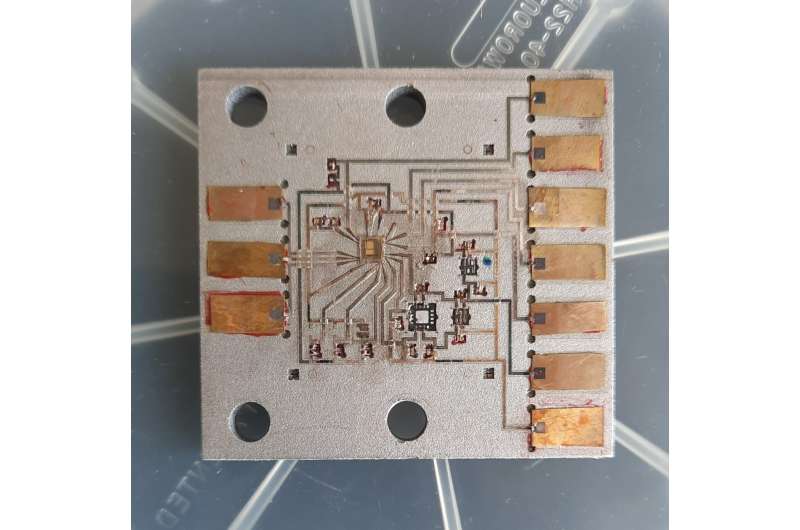Engineers test printed electronics in space

Small spacecraft today pack sensors, guidance, control, and operating electronic into every space available. Future missions could benefit from the printing of electronic circuits onto the walls and structure of spacecraft.
In a sounding rocket launch from NASA’s Wallops Flight Facility in Virginia, near Chincoteague on April 25, engineers successfully tested hybrid printed-circuits at the edge. Sensors printed on two panels and the door of the payload compartment monitored the SubTEC-9 sounding missile mission. They recorded data and sent it to the ground.
The NASA Goddard Space Flight Center’s Greenbelt, Maryland Goddard Space Flight Center experiment, conducted by Beth Paquette, an aerospace engineer, and Margaret Samuels, an electronics engineer, was designed to demonstrate the space-readiness printed electronics technology.
Samuels stated that the uniqueness of this tech is its ability to print sensors exactly where they are needed. “The biggest benefit of this technology is that it saves space. We can print on 3-dimensional surfaces with traces of about 30 microns—half the width of a human hair—or smaller between components. This could have other benefits, such as for radio frequency and antenna applications.
The ink that detects humidity was developed by NASA Marshall Space Flight Center, Huntsville, Alabama. The University of Maryland Laboratory for Physical Sciences created the circuits with partners.
Brian Banks, Wallops electronics engineer, explained that printed circuits offer a level of functionality not possible with conventional electronic modules. Banks stated that “the hybrid technology allows circuits be fabricated at locations which would normally not be available for traditional electronics modules.” Printing on curved surfaces can also be useful for small sub-payloads that are deployed in very tight spaces.
Jason Fleischer of LPS designed and printed the circuits used in the April flight, using printers able to produce electronic traces that are thinner than what the eye can see.
According to him, the SubTEC-9 launch was a major milestone in LPS’s validation and development of printed-circuit techniqe.
Fleischer explained that “every part must work during the flight” and “a successful data-return means all circuits are up and running.” I am excited about this success, as well as the possibility of getting on another rocket to have more successes.
The team has printed circuits around corners, curves and flexible parts. In another experiment, they printed X ray instruments onto flexible strips of Kapton. The team has developed guidelines for mission and instrument engineers so that they can easily adopt these circuits.
Functional and Performance Improvements
Samuels stated that printed circuits offer a great advantage when it comes to predictability and stability of antenna design and connections. We can print an antenna on a curved, e.g. outside surface of a spacecraft or rocket. This will increase the angles from which the antenna can receive and send signals into space.
Wire bonding is a traditional method of connecting antennas. It involves melting a metal cable to the antenna, and then attaching it to the signal processing electronic. Samuels explained that the process can be messy, inexact and makes it hard to use precision antenna technology.
She said, “It is a little like sewing with metal thread.” There are conferences dedicated to discussing the failure mechanisms of wire bonding. “The idea that printed connections can replace wire bonding is a huge improvement.”
Paquette stated that future missions could be printed temperature sensors all over the vehicle’s interior. Such a mission, which would cost a little money, could help us better understand how the heating and cooling of the entire spacecraft is affected when it approaches the sun.
Ryan McClelland, an engineer at NASA’s Goddard Space Flight Center located in Greenbelt Maryland, was impressed by their work. McClelland is credited with NASA’s first use of Evolved Structures (spacecraft parts created by artificial intelligence). “I can imagine using their printed electronic to add functionality and to parts that were designed by AI, 3D-printed or manufactured in space.”
The team was excited to watch the SubTEC-9 launch. They were able to retrieve their data and experiment while also advancing technology that could allow for new design flexibility.
Samuels: “We’re excited to see that the rocket test will validate our printed sensor technology.”
Citation:
Engineers test space-based printed electronics (2023, 27 July)
Retrieved on 26 July 2023
from https://phys.org/news/2023-07-electronics-space.html
Copyright is applied to this document. This document is protected by copyright.
No part of the website may be reproduced or copied without written permission. This content is only provided as information.